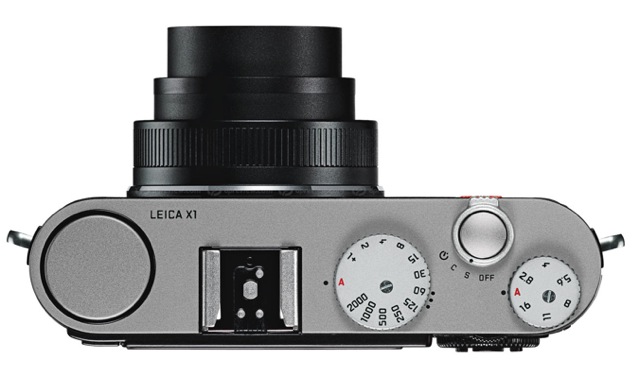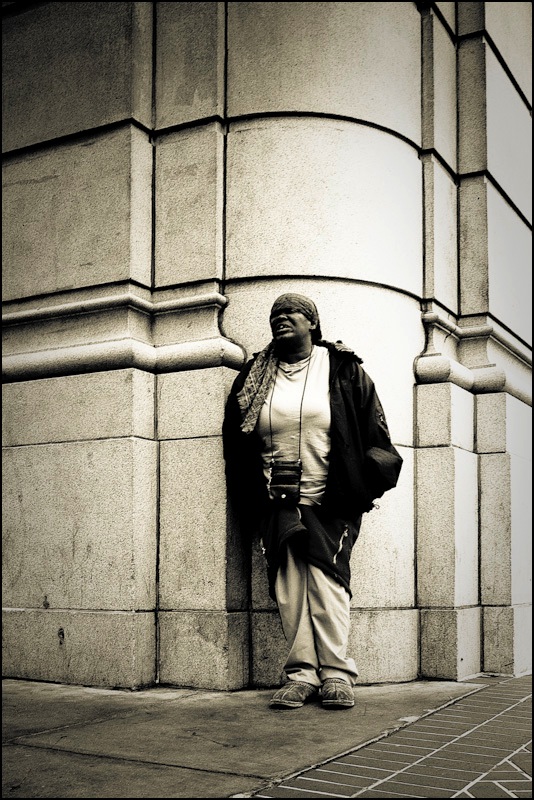Some thoughts.
It’s 9/9/09 and Leica finally introduced its full frame digital M9. I won’t be dwelling on it here as I doubt there’s much need for, or interest in, a $10,000 camera (with lens) which comes with almost no automation, bulky lenses and a near total lack of weatherproofing. For that sort of money there are several rugged and capable DSLRs available from other makers and the specific situations in which a rangefinder camera excels are few and far between. Street snapping is probably the main genre where the r/f is most at home. A good reality check may be found here.
Leica has also introduced the X1, a fixed lens (35mm equivalent) APS-C body with a very appealing design. They deserve hearty congratulations on this as it’s not yet another rebadged Panasonic, though the premium price of $2,000 is hard to swallow. Plus you will need to add an optical viewfinder to make the thing workable in street situations which adds more cost. With v/f and with its non-detachable lens extended it’s much the same size as the G1 or GF1:

Leica X1
Note the full manual operation afforded by separate shutter and aperture dials.
So who needs this? Well, my perspective has altered significantly in the two short months during which I have owned the Panasonic G1. Having been a street snapper since childhood and having given up on film when the Canon 5D came along, I have been waiting for the ‘digital Leica’ a long time. And the G1 has changed how I think about street cameras.
In days of yore you would load up your little shoulder bag with a 35 and 90mm Leica lens, leave the 50mm on the M2 or M3 slung over your shoulder, and cram in a few rolls of film wherever you could stash them. After decades of use all the manual adjustments required became second nature – aperture, shutter speed, focus and the endless tedious changing of film in fair weather or foul (mostly foul in my London days). The results of those early efforts can be seen in all their monochrome splendor here. You didn’t complain because there not only was no alternative, no one saw digital coming. And SLRs were too loud and bulky and noisy to be an alternative for the truly unobtrusive and relatively quiet Leica M. You just learned to pre-visualize the image and would change lenses on the run to make sure the right one was in place by the time you pressed the button. And it made sense to have the right lens in place as film could only handle so much enlarging.
When the 5D came along you suddenly had medium format film quality at an affordable price with full automation thrown in. The bulk seemed modest compared to my Rollei 6003 and the ergonomics superior, but no one could accuse the 5D of being a street snapper. Landscapes, macro still lifes, portraits, QTVRs, HDR, all well and good, but unobtrusiveness is not that camera’s strong point.
So along came the Panasonic LX-1 with its host of compromises. Shutter lag, slow autofocus, an awful LCD screen replaced with a glued-on optical finder and too small to handle easily in a hurry, yet it was the best this street snapper could find at the time.
But the digital Leica did finally come along and the logo said ‘Lumix G1’.
After the first few hundred street exposures you realized that the craving for the rumored 20mm f/1.7 (now available) pancake lens was gone. I don’t need f/1.7 but I do occasionally like 35, 50 and 90mm focal lengths, much as I did in the M2/M3 film days. And the G1 went one better at the wide end, stretching to 28mm.
But it’s the total automation and that revolutionary Electronic View Finder which make the G1 the digital Leica. No need to change lenses. No need to excuse the quality of the kit lens or sensor, both small and superb. No need to wait for autofocus – in 1,200 exposures I have ‘beaten’ the AF just once. It’s that good. And as for the sensor, you may not want to make 30″ prints (who any longer makes these regularly?) but 13″ x 19″ is par for the course. And no need to set anything other than the aperture or squint into a dark finder trying to figure out what the camera is doing. The automation is outstanding and the EVF even better. In fact it’s pretty close to my wish list. Best of all, you can set the frame aspect ratio to 3:2, just like in that Leica of yore, and that’s how I use my G1.
So while Leica has done a fine aesthetic job (let’s just hope the shutter and focus delays are low) in designing the X1, I really question who needs a fixed focal length camera at such a price when you can have a more versatile tool with the same bulk for under one third of the cost? The only thing the G1 has which I have realized that I do not need is the interchangeable lens. The kit lens is this street snapper’s ideal.

Distraught. G1, kit lens, 14mm, f/5.6, 1/400, ISO100.
So yes, the digital Leica is here. It just happens to be made by someone else.
Great article. But I have one question: how do you manage to work with the EVF under harsh and very contrast light? I’m having some trouble with the G1’s EVF…
Hi, I was just wondering specifically what about the G1 besides the fast autofocus and good kit lens makes it the ideal street snapper? A lot of other cameras seem to have the same capabilities. The EVF seems like it would help in high light situations from an overwashed LCD but I would think the swivel LCD offers more opportunities for unique holding angles.
Carlos – you can turn down contrast and brightness using the camera’s software.
Jae – LCDs are useless for my intended purpose. The G1 has a 100% full size v/f, not the tunnel vision offered by the alternatives. The actual magnification ratio is 0.72x, identical to that of the Leica M2 and I am nothing if not used to that. And the camera’s compactness and quietness are the closest thing to my mainstay of film days – the Leica M. Finally, it’s the first VF where I can actually see on screen data in bright light – for me that mean the +/- exposure adjustment in particular. My standard for comparison as regards viewfinders is my 5D and, simply stated, there is no comparison. The G1’s v/f is in a different league. Add the fact that it’s the first SLR with proper DOF preview (the screen does not darken, so you actually see the DOF) and that’s all she wrote!
Fair enough, I’ve read that the EVF can actually be laggy but have not tried it myself. How do you feel about the LX3? I’m possibly thinking about returning it for a G1 but I really like the portability of just slipping it in my jacket on the way out the door.
I have not used the LX-3. I use the LX-1. By comparison for my purposes it’s slow, hard to handle, constantly wants to retract the lens (or burn up the battery) and needs a glued on v/f to make sense. Depends very much on your goal – my sole use for the G1 is street candids. Nothing else. Many of those I have published here would not have been possible with the LX-1. It’s simply too slow. And a 13″x19″ print from the LX-1’s sensor really is at the limit – even at ISO 80 noise intrudes. I don’t like noise.
I use the 5D for everything else – very large prints, Helicon Focus, QTVRs, HDRs – click the appropriate section in the right hand column for more. The 5D is to the G1 what the Rollei/Hasselblad was to the Leica in film days, if you get my drift. The LX-1 I keep in the glove compartment ….
I don’t do street photography, but ran into the same issues for my needs with an LX-2 as a sidekick to my DSLR system. I went for an Olympus E-P1 as a new compact camera alternative an found it frustrating to deal with. The AF is slow, but even when I don’t need speed or I’m working methodically with manual focusing lenses, I had a hateful time working with only an LCD viewfinder. I finally got [over] (ed.) my aversion to the G1’s styling and the small increase in size and just got one. It’s only a little larger than the E-P1, but it’s a much more capable camera for my needs. The EVF lag is a small negative compared to having to shoot chimp-style with an LCD under adverse lighting. The AF is much faster, and the camera seems to have less lag as well. The G1 provides more direct controls over frequently used settings.
Thomas,
in response to your great article:
http://forums.dpreview.com/forums/read.asp?forum=1041&message=32996038
Kind regards,
Helmut
Frankly, this is all a bit mystifying to me. The G1 is a wonderful tool, but in terms of size, bulkiness and weight it belongs to the other small dslr’s. Not much difference there between m4/3 and 4/3; the lenses are a bit smaller, but the camera is still in a completely different category from the leica x-1 or the olympus ep-1 with the pancake lens and the like, which you can carry with you anytime anywhere, a bit heavier and bigger than a point and shoot camera but still pocketable. So I guess there are still many of us out there still waiting for an affordable leica like the X-1 but with an integrated viewfinder, or a camera of the canon G 10 with a somewhat larger sensor and above all an integrated viewfinder that is not ridiculously small and inaccurate.
Peter Halter
I have got some great street photos from a Canon G9 & Lumix LX3 and have got great A3 prints from both cameras, maybe if the X1 Leica got a little viewfinder without having to switch on the LCD every time I want to take a pic and the X1 was half the price I might have bought one.